Lake Inarijärvi - the rugged salmonoid lake of the North
Photo: Lentokuva Vallas There are more than 3,000 islands in Lake Inarijärvi.
‘The week's trip on Lake Inarijärvi is drawing to a close. The wind is blowing whitecaps over the wide open Kasari. We are waiting out the weather in our tents on the sheltered Selkälahdensaari Island, so as to return to our car over the big mid-lake area. Covered in ice in the cool box lie the fillets of the big arctic char that we caught yesterday. We haven't seen a soul for two days.'So goes one traveller's story from Lake Inarijärvi, the largest lake in Lapland and the third largest in the whole of Finland. For anglers, it offers a unique setting in the wilderness, pristine waters and handsome fish. Lake Inarijärvi is one of a kind in Europe; there are few places where you can fish in as much peace as here. You can glide along the wide open mid-lake areas for days on end, taking in the unspoilt nature, without meeting a soul. Except for a few villages and abandoned cabins, the shores are unspoilt by buildings. Wild trout Lake Inarijärvi is the number one spot in Finland for fishing brown trout. In recent years, trout catches have amounted to about 45 tonnes. The normal size of a brown trout varies between one and three kilos, but here trollers may entice real record-breaking whoppers on the end of their lines. The largest specimens caught on Lake Inarijärvi have weighed more than ten kilos. The best part is that trout reproduce in rivers flowing into the lake. Photo: Jari Salonen 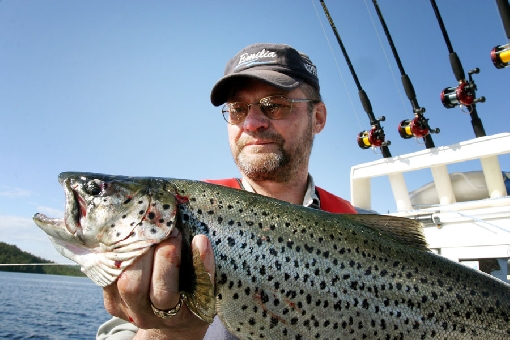 A 2.6-kilo trout from a deep in Nanguvuono Fjord. In the early season, which means late June on Lake Inarijärvi, you can find trout at a few metres, at the mouths of bays, at the tips of shallows and in the sounds around mid-lake islands. In the last case, you can hook a trout by spinning from the shore of your campsite island. Once the waters warm up past 10 degrees, brown trout move in deeper waters. Good fishing spots include steeply sloping island shores and fingers of deep water (10–30 m) sticking into the midst of shallow waters. During the white midsummer nights, you can also find brown trout right at the surface or at a few metres in areas where waters are 20–40 metres deep and at the flanks of mid-lake shoals. Deep wide mid-lake areas will seldom yield any catches. From mid-July to August, it's worth sinking some of your lures down to 10 metres. In autumn, brown trout will return to shallow waters. Autumn conditions are often rainy and windy, but if you're having a good day, your trout catch may be all the more impressive. Photo: Petteri Kontila 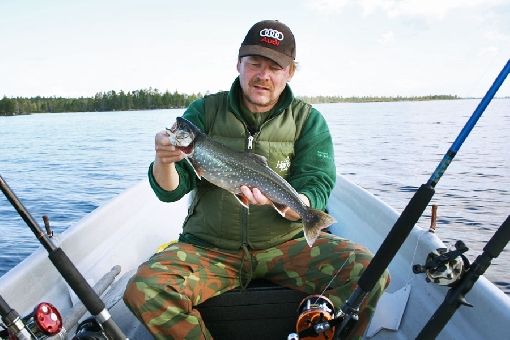 The wide open Kasariselkä area of Lake Inarijärvi yields arctic char. Arctic char strike spoons from the deep Arctic char is another splendid game species on Lake Inarijärvi. Ordinarily, arctic char weigh between 0.7 to 2 kg, but specimens weighing as much as several kilos are possible – record fish have weighed eight kilos. When waters are cool, you can catch an arctic char from surface waters. In summer, they strike spoons at 10 to 20 metres. Lake trout are eager to snatch a lure at 20 to 30 metres or sometimes in quite shallow waters. Grayling with spinners from shoals Spinning anglers can catch handsome grayling from the rocky shores of mid-lake islands. The stock is strong and grayling weighing 0.5 to 1 kg are common on Lake Inarijärvi. A gentle wind is beneficial when pursuing grayling and windward shores make for great hot spots. Good spots for catching grayling include sounds next to islands dividing open mid-lake areas. In late July, you can catch big grayling at 2 to 4 metres in the bights of mid-lake islands. Photo: Petteri Kontila 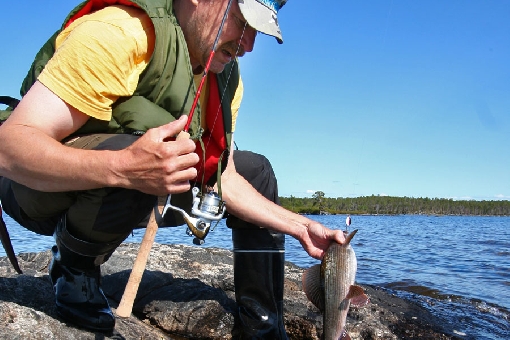 Grayling can be caught with spinners from the shores of mid-lake islands and shoals. Whitefish with flies The whitefish stock is good and fly-fishers have the best chances of finding them in the warm conditions of early summer, when they go to feed in soft-bottomed bays. At peak feeding times, whitefish also strike spoons. Bottom-dwelling whitefish grow to weigh as much as several kilos, but regular catches fall short of one kilo. From the deeps of Lake Inarijärvi – at river mouths in particular – your lure may also be snatched by a pike, but this species is quite scarce in these cold waters. Pursuing the red-fleshed with jigging lures Similar to many other waters in Lapland, grayling can be found in winter right next to the shores and at the edges of shoals. When the water level is low, a good fishing depth is 1 to 2 metres. Around May Day, the water level starts to rise and this is when you can catch big grayling from pockets formed between rocks at less than half a metre. Even trout may grab a jigging lure in the midst of your pursuit of grayling. Ice-fishing arctic char in winter is a challenging sport on Lake Inarijärvi; you need to sink your jigging lures to a depth of 10 to 20 metres. The Joensuunselkä mid-lake area off Veskoniemi Point is one of the most reliable ice-fishing spots for perch. Photo: Risto Jussila 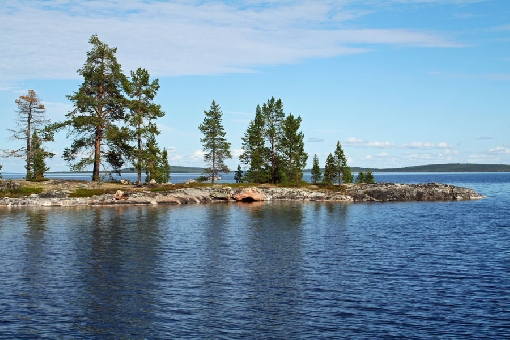 The mid-area of Nanguvuono Fjord in the southeastern part of Lake Inarijärvi. Islands and wide open mid-lake areas The most extensive mid-lake areas on Lake Inarijärvi are Kasariselkä, Vasikkaselkä, Sammakkoselkä and Ukonselkä. The Kasariselkä area is more than 30 kilometres long and you cannot even see the opposite shore. Lake Inarijärvi is a rift lake with very deep water. The bottom formation is highly variable. Extensive island areas, shoals and bay areas are part of the scenery, complete with deep trenches found in the wide open mid-lake areas. Precipices and nearby hills rise straight from the water to a height of dozens of metres, but these are balanced out by smooth cliffs and sandy beaches. Rocky islands with barkless pine snags are characteristic of Lake Inarijärvi. A lifetime is not enough to test all the fishing grounds of this lake. Photo: Markku Myllylä 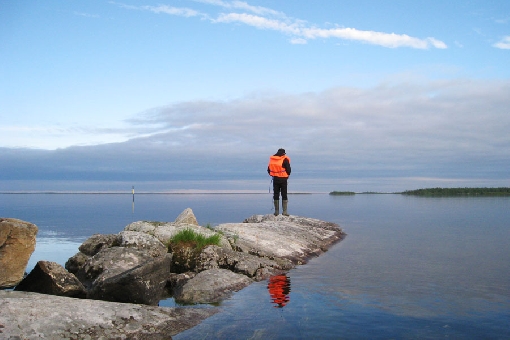 The placid mid-lake area of Lake Inarijärvi soothes your mind. No need to bring drinking water Water quality in Lake Inarijärvi is excellent. The water is cold even in summer; mid-lake water temperatures generally remain below 15 degrees. The water is clear and drinkable. In northern parts of the lake, you can see to a depth of 9 metres. People living in Tampere believe that Paarlahti Bay in Lake Näsijärvi is the only fjord in Finland. In reality, this is where you can actually find the longest fjords in the country. Nanguvuono, Kaikunuora, Surnuvuono and Suolisvuono Fjords are long, narrow and deep and, like other parts of the lake, brimming with fish. Due to its wild nature, anyone heading to Lake Inarijärvi needs to respect the natural conditions at play there. The wind may sometimes rise unexpectedly fast and reach dangerous proportions in these near-marine conditions. In the wilderness, help is a long way off. Accommodation sites are available in the Municipality of Inari and in villages close to the lake. Anglers taking a fishing trip on Lake Inarijärvi often camp in tents or stay in abandoned cabins. There are also two cabins available for advance booking in the lake area. |